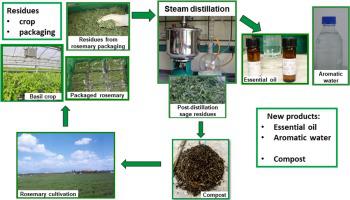Industrial Crops and Products ( IF 5.9 ) Pub Date : 2021-01-19 , DOI: 10.1016/j.indcrop.2021.113255 Massimo Zaccardelli , Graziana Roscigno , Catello Pane , Giuseppe Celano , Marisa Di Matteo , Marika Mainente , Alessandra Vuotto , Teresa Mencherini , Tiziana Esposito , Antonella Vitti , Enrica De Falco

|
In the last few years, the aromatic plant market for fresh consumption has been growing, especially packaged herbs for Mass Market Retailers. Pruning and selection of aromatic plants during packaging leads to the accumulation of a large amounts of plant residues with consequent disposal costs. In a circular economy perspective, the aim of this study was to recover residues of three aromatic plants (Ocimum basilicum L., Rosmarinus officinalis L. and Salvia officinalis L.) by extracting essential oil and aromatic water and, subsequently, reusing oil-free biomasses for composting. In fact, these by-products are currently considered very interesting and sustainable. The essential oils are natural products that have a wide range of biological activities useful for pharmaceutical, medical, veterinary and agriculture innovative purposes. Hydrolates have a much softer scent than the corresponding essential oils. The compost can be successfully applied for the restoration and maintenance of soil fertility. Results of this study showed that yields of essential oils obtained from plant residues, were sufficiently higher, especially for sage and rosemary, also if they were collected well far from plant balsamic period. Analysis of composition of essential oils confirmed the presence of characteristic compounds for each species. The aromatic waters were found to be an easily usable product due to the favourable physicochemical characteristics and, in particular, the aromatic waters of basil showed high antioxidant activity. About compost, the main physicochemical (humidity, pH, electrical conductivity) and biological (basal respiration and hydrolase activity) properties, were considered. Phytotoxicity tests indicated that composts derived from the three species can be used in agriculture. This research demonstrates that it is possible to eliminate completely plant residues and recover new products from aromatic species, supporting the effectiveness of an eco-friendly model to recover and reuse all fresh aromatic plant residues.
中文翻译:

通过回收芳香植物供应链中的植物残渣获得的精油和优质堆肥
在过去几年中,用于新鲜消费的芳香植物市场一直在增长,尤其是面向大众市场零售商的包装草药。包装过程中芳香植物的修剪和选择会导致大量植物残留物的积累,从而产生处置费用。从循环经济的角度来看,本研究的目的是回收三种芳香植物(罗勒属罗勒,迷迭香和丹参)的残留物。L.)提取精油和芳香水,然后再利用无油生物质进行堆肥。实际上,目前认为这些副产品非常有趣且可持续。精油是具有广泛生物活性的天然产物,可用于制药,医学,兽医和农业创新。氢化物的气味比相应的香精油柔软得多。堆肥可以成功地用于土壤肥力的恢复和维持。这项研究的结果表明,从植物残渣中获得的香精油的收率足够高,尤其是对于鼠尾草和迷迭香而言,即使它们的采集距离植物香脂期很远也是如此。对精油成分的分析证实了每种物种均存在特征性化合物。由于良好的理化特性,发现芳族水是易于使用的产品,特别是罗勒的芳族水显示出高的抗氧化活性。关于堆肥,考虑了主要的理化性质(湿度,pH,电导率)和生物学性质(基础呼吸和水解酶活性)。植物毒性测试表明,来自这三个物种的堆肥可用于农业。这项研究表明,有可能完全消除植物残渣并从芳香族物种中回收新产品,从而支持建立一种生态友好型模型来回收和再利用所有新鲜芳香植物残渣的有效性。由于良好的理化特性,发现芳族水是易于使用的产品,特别是罗勒的芳族水显示出高的抗氧化活性。关于堆肥,考虑了主要的理化性质(湿度,pH,电导率)和生物学性质(基础呼吸和水解酶活性)。植物毒性测试表明,来自这三个物种的堆肥可用于农业。这项研究表明,有可能完全消除植物残渣并从芳香族物种中回收新产品,从而支持建立一种生态友好型模型来回收和再利用所有新鲜芳香植物残渣的有效性。由于良好的理化特性,发现芳族水是易于使用的产品,特别是罗勒的芳族水显示出高的抗氧化活性。关于堆肥,考虑了主要的理化性质(湿度,pH,电导率)和生物学性质(基础呼吸和水解酶活性)。植物毒性测试表明,来自这三个物种的堆肥可用于农业。这项研究表明,有可能完全消除植物残渣并从芳香族物种中回收新产品,从而支持建立一种生态友好型模型来回收和再利用所有新鲜芳香植物残渣的有效性。罗勒的芳香水具有很高的抗氧化活性。关于堆肥,考虑了主要的理化性质(湿度,pH,电导率)和生物学性质(基础呼吸和水解酶活性)。植物毒性测试表明,来自这三个物种的堆肥可用于农业。这项研究表明,有可能完全消除植物残渣并从芳香族物种中回收新产品,从而支持生态友好型模型的有效性,以回收和再利用所有新鲜的芳香植物残渣。罗勒的芳香水具有很高的抗氧化活性。关于堆肥,考虑了主要的理化性质(湿度,pH,电导率)和生物学性质(基础呼吸和水解酶活性)。植物毒性测试表明,来自这三个物种的堆肥可用于农业。这项研究表明,有可能完全消除植物残渣并从芳香族物种中回收新产品,从而支持生态友好型模型的有效性,以回收和再利用所有新鲜的芳香植物残渣。植物毒性测试表明,来自这三个物种的堆肥可用于农业。这项研究表明,有可能完全消除植物残渣并从芳香族物种中回收新产品,从而支持生态友好型模型的有效性,以回收和再利用所有新鲜的芳香植物残渣。植物毒性测试表明,来自这三个物种的堆肥可用于农业。这项研究表明,有可能完全消除植物残渣并从芳香族物种中回收新产品,从而支持生态友好型模型的有效性,以回收和再利用所有新鲜的芳香植物残渣。


























 京公网安备 11010802027423号
京公网安备 11010802027423号